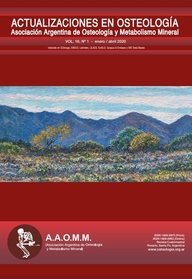¿A qué pregunta responde el hueso? Una cuestión de direccionalidad estructural y organización biológica (hueso y huesos, del big-bang a la osteoporosis)
Autores: José L. Ferretti, Nicolás Pilot, Leandro Pisani, Sergio Lüscher, Leandro Mackler, Gustavo R. Cointry, Ricardo F. Capozza
Resumen
La razón de ser de nuestros huesos y esqueletos constituye un dilema centralizado en los conceptos biológicos de estructura y organización, cuya solución necesitamos comprender para interpretar, diagnosticar, tra¬tar y monitorear correctamente las osteopa¬tías fragilizantes. Últimamente se ha reunido conocimiento suficiente para proponer apro¬ximaciones razonables a ese objetivo. La que exponemos aquí requiere la aplicación de no menos de 6 criterios congruentes: 1) Un criterio cosmológico, que propone un origen común para todas las cosas; 2) Un criterio biológico, que explica el origen común de todos los hue¬sos; 3) Un enfoque epistemológico, que de¬safía nuestra capacidad de comprensión del concepto concreto de estructura y del concep¬to abstracto de organización, focalizada en la noción rectora de direccionalidad espacial; 4) Una visión ecológica, que destaca la importan¬cia del entorno mecánico de cada organismo para la adecuación de la calidad mecánica de sus huesos a las funciones de sostén que les adjudicamos; 5) Una correlación entre todo ese conocimiento y el necesario para optimi¬zar nuestra aptitud para resolver los problemas clínicos implicados y 6) Una jerarquización del papel celular en el manejo de las interacciones genético-ambientales necesario para asimilar todo el problema a una simple cuestión de or¬ganización direccional de la estructura de cada hueso. Solo aplicando estos 6 criterios estaría¬mos en condiciones de responder a la incóg¬nita planteada por el título. La conclusión de esta interpretación de la conducta y función de los huesos debería afectar el fundamento de la mayoría de las indicaciones farmacológicas destinadas al tratamiento de la fragilidad ósea.
Palabras clave: biomecánica ósea, estructura ósea, organización, direccionalidad, osteopa¬tías fragilizantes, osteopenia, osteoporosis.






